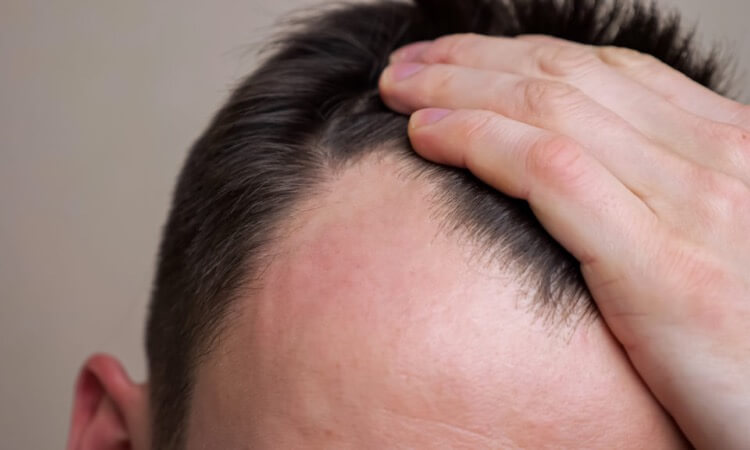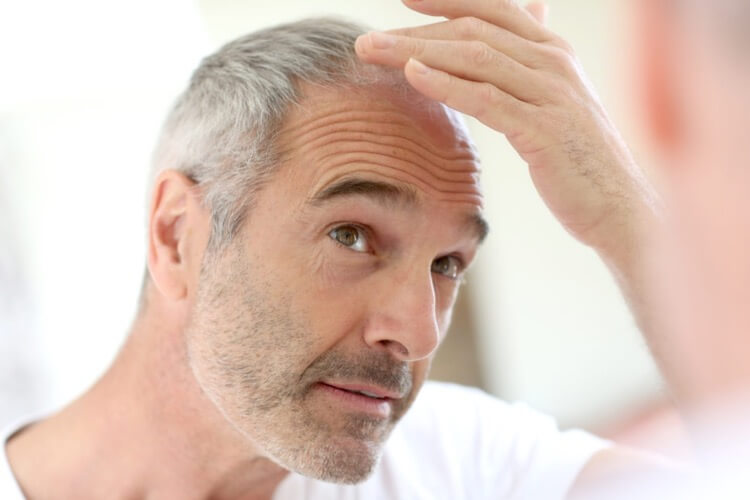Do You Need a Hair Loss Doctor? – How to Know When It’s Time for a Professional Opinion.

Did you know that many types of hair loss can be reversed? If you didn’t, you’re not alone. According to a 2018 study that evaluated why people don’t seek treatment for their hair loss, a significant number of people with androgenetic alopecia aren’t aware that treatments are available to help them regrow their hair. (01) This is one reason why people don’t seek medical attention when their hair is thinning or balding. However, if you are experiencing male or female pattern baldness, not only can treatment help you regrow your hair, but the earlier you begin treatment, the better your results.
Nobody wants to leave work early or spend money on doctor’s appointments that aren’t necessary. Life is way too busy for that. So, how do you know whether your hair loss warrants a visit? Here’s a guide to help you with everything you need to know, from when it’s time to get a professional opinion to what type of doctor you’ll need.
How Much Hair Loss is Too Much?
Everyone sees a few strands of hair in the sink or on the shower floor from time to time. That’s a normal part of the hair growth cycle and is expected. Losing 50 to 100 hairs during the shedding phase is normal. How do you know if you’re losing more than that, though? Here are a few signs:
Gradual Hair Loss
- Thinning on top of your head
- Growing bald spot
- Receding hairline
- Widening center or side part
- Thinning ponytail
Sudden Hair Loss
- Seeing a bald spot or area appear within 1 or 2 days
- Losing clumps of hair
- Watching all or most of your hair fall out all at once
Both Gradual and Sudden Hair Loss Requires Medical Attention
Whether you notice gradual or sudden hair loss, we recommend you seek medical attention. In addition to losing hair on their heads, some people lose hair on their face and their bodies. If you notice bald spots or missing hair in areas such as your eyebrows, eyelashes, beard, mustache, or other areas, that also warrants a doctor’s visit.
Male and female pattern baldness is the most common type of hair loss, and usually does not have any accompanying symptoms besides hair loss. However, people with other types of alopecia such as alopecia areata and lichen planopilaris may experience burning, stinging, itching, or tenderness resulting from inflammation. If this is the case for you, treatment is needed as quickly as possible to limit the amount of hair lost and have the best possible chance of regrowth.
What Type of Doctor Treats Hair Loss?
Finding the right person to help diagnose and treat your hair loss can be tricky. There are a lot of different types of practitioners who claim to help people with their thinning hair and bald spots. Here’s a rundown of who’s who:
Trichologist
A trichologist is a specialist who focuses on treating hair and scalp diseases. Although trichologists have specialized training, they are not medical doctors. They can’t write prescriptions or perform medical or surgical procedures.
Holistic Medicine Doctors (Naturopaths)
A holistic medicine doctor focuses on a whole-body approach to improving health and wellness. Rather than just looking at symptoms, naturopaths evaluate a patient’s mind, body, and spirit. Prevention comes first, and treatment comes second. Although holistic medicine doctors can order lab tests and use botanical therapies, they cannot write prescriptions unless they also hold medical degrees.
Dermatologist
A dermatologist is a medical doctor trained to treat skin, hair, and nails. Dermatologists have the training and expertise necessary to conduct a full evaluation, run any necessary tests, and prescribe medications if needed. Some dermatologists have more specialized training and experience working with hair loss than others. When selecting a dermatologist, ask questions such as what hair loss conditions he or she typically treats and what treatments are most often used.
Why Self Diagnosis is a Bad Idea
There are many good reasons why you should get a professional diagnosis. Access to the wealth of online information may make you feel like an expert, but you’re not. You may come to the wrong conclusion about why you’re losing your hair. Another reason why is that using ineffective medication is expensive. There is an abundance of nonmedical treatments on the market, such as vitamins, supplements, shampoos, and topical solutions, but research indicates that they have temporary or little effect on hair growth. The cost of over-the-counter treatments is actually higher than the cost would be for proven, supervised medical treatments. (02)
How a Hair Loss Doctor Makes a Diagnosis
Dermatologists use a staged approach to evaluating hair loss conditions. Typically, he or she will review your medical history to determine if there’s a pre-existing or new condition that is causing your hair loss. Whether your hair loss is gradual or sudden, your hair loss pattern will point your doctor in the right direction during your evaluation. For example, androgenetic alopecia usually presents with thinning on top, a receding hairline in men, and a widening part in women. Bald spots about the size of a quarter are often seen in patients with alopecia areata. A microscope can see if there is any redness caused by inflammation from scarring alopecia or a possible fungal infection.
Other tests sometimes used include a pull test to see how much and easily hair falls out. Usually, just a visual exam is all that is needed to diagnose androgenetic alopecia. However, if your doctor needs more information, biopsies are the gold standard for a diagnosis.
Treatment Options Available Through Hair Loss Doctors
Hair loss treatment depends upon the condition that is diagnosed. The most proven, commonly prescribed medications include:
Minoxidil
Topical Minoxidil, a vasodilator that increases the amount of oxygen to the scalp, is often prescribed to treat male and female pattern baldness and various other types of alopecia. Minoxidil is available over-the-counter in two and five-percent liquid and foam topical formulas. Higher topical doses and oral pills are only available by prescription. It’s best to use Minoxidil under a doctor’s supervision. Once you start using the medication, any hair that has grown can be lost if you stop taking it.
Finasteride
Finasteride is a topical and oral medication only available by prescription. The medication is typically prescribed to treat androgenetic alopecia; however, it has been proven effective for generating hair growth among patients with lichen planopilaris and other types of alopecia. (03) Finasteride works by blocking the production of DHT, which causes hair loss. Finasteride has a reputation for causing sexual side effects among men. If this concerns you, talk to your doctor about using topical formulas instead. Topicals work equally as effectively without side effects. (04)
Dutasteride
Finasteride is effective for most patients and is usually used as a first-line medication to treat hair loss. If you do not respond to Finasteride, your doctor may recommend trying Dutasteride, which works similarly to Finasteride. The difference between the two medications is that Finasteride inhibits one type of isoenzyme, while dutasteride inhibits two types.
Spironolactone
If you are a woman, your doctor may recommend Spironolactone, which blocks aldotestosterone, a hormone produced in the adrenal glands. Spironolactone is not usually prescribed to men since it can cause feminizing side effects.
Combination Treatments
Some types of alopecia require a combination of medications. For example, doctors often prescribe Minoxidil and Finasteride simultaneously. Minoxidil enlarges the hair follicles, while Finasteride prevents testosterone from converting to DHT. Retinol helps the absorption of other topical hair treatments, and cortisone can be added to prevent irritation.
Protein Rich Plasma (PRP)
Protein Rich Plasma treatments are a three-step process that involves drawing and separating your blood and injecting the separated platelets. Protein derived from the PRP process is believed to help your hair grow by encouraging cell growth. Only licensed practitioners can perform this medical procedure.
Hair Transplant Surgery
Hair transplants are becoming more common thanks to improved techniques that have been developed throughout the years. Because hair transplants are a type of surgery, doctors performing hair transplants must be licensed.
Why Prescription Hair Loss Medications are Superior to Over-the-Counter Treatments
As you’re probably already aware, the number of products on the market to treat hair loss is pretty overwhelming. Trying out a new shampoo that you find on Amazon may be harmless but could cost a lot of money without much hair gain. The window to regrow your hair could also close while you’re experimenting. The difference between the OTC products and what your dermatologist prescribes is research. It may not sound like much, but it’s a big deal. Clinical studies provide dermatologists with a scientific basis for providing advice and treatment. Clinical studies are also FDA-regulated, ensuring safety and properly reported results.
Need a Hair Loss Doctor? We Can Help.
Finding a dermatologist who is also a hair specialist can be difficult. If you have questions or are interested in treatment for your alopecia, contact us. Our licensed dermatologists will consult with you to determine whether you would benefit from using Happy Head or any other type of medication that treats hair loss.
Resources:
(01) https://www.ncbi.nlm.nih.gov/pmc/articles/PMC6029958/
(02) https://www.ncbi.nlm.nih.gov/pmc/articles/PMC6029958/
(03) https://www.ncbi.nlm.nih.gov/pmc/articles/PMC4809380/
(04) https://www.ncbi.nlm.nih.gov/pmc/articles/PMC4314881/#:~:text=Studies%20show%20that%20topical%20finasteride,post%2D%20treatment%20with%20oral%20finasteride.





